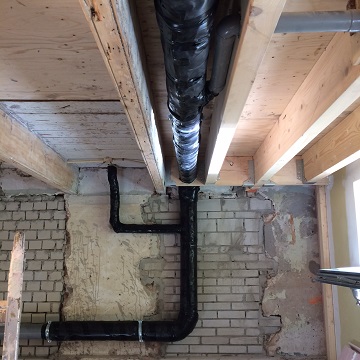Tube and pipe insulation
The draining of air, rainwater, or matter through tubes and pipes can cause a considerable amount of noise pollution. By draining the drainage channel starts to move and subsequently radiates sound. Especially with relatively light PVC pipes, this forms a problem. With our range of pipe insulating products and auxiliary materials, this noise problem can easily be reduced to an acceptable level.
The products
In order to insulate pipes, tubes and drains you can use Merfolood or Merfisol.
Tools
When mounting Merfisol, containing an aluminium top layer, use the IsoTape Alu, and for the Merfolood use IsoTape Masking Tape.
The difference between Merfolood and Merfisol
The two biggest differences between Merfolood and the Merfisol is the higher fire certification of Merfisol and the user-friendliness of Merfolood. The inside of Merfisol consists of a plastic-like material. The name "Merfolood" derives from the inside that contains lead. The products' price is therefore influenced by lead prices. The advantage of lead is that it has a high melting point, about 600 degrees, and that it is a very dense material. More information about, among others, the insulation values can be found in our product range.
Processing Merfolood
Since Merfolood is ‘malleable’ pipe insulation, gluing is not necessary. This is a so-called ‘Fold 'n Hold’ product. Knead the merfolood around a tube or pipe, the product is mounted in an instant. Wrap the Merfolood twice, at least around the curves, but preferably around the entire tube or pipe for an optimal result. Finish the seams with the type of IsoTape that best fits the product. Wrap it around the insulated pipe every other 40 centimetres. The product is now mounted, and the pipe is insulated! The kneading does leave some dents in the material, but in general this is not a problem if these parts of the pipe or tube don't catch the eye.
- Step 1
Material Calculation. In order to know how much Merfolood you will need, calculate the circumference and length of the pipe (the circumference is 3.14 x the diameter). Please note that you cover the curves twice. Of course, the best result is a double wrapping of the entire tube.
- Step 2
Loosen some mounting brackets and clean the pipe or tube.
- Step 3
Cut the product to size with a sharp hobby knife. Provide at least 5 cm extra to cover the seams as this prevents sound leaks. - Step 4
Wrap the product tightly around the pipe, knead and shape while wrapping it around the pipe to make sure it is prepared for the next step.
- Step 5
Tape the seams and wrap IsoTape twice around the insulation every other 40 cm, the pipe or tube is now well insulated. - Step 6
Place the mounting brackets over the insulation material and put the pipe in place. The pipe is now somewhat disconnected from the construction as well and properly insulated!
Merfisol processing
Merfisol is more resilient than Merfolood and therefore less easy to 'knead around a pipe, so that it stays in place. If somebody is available to help you, you can mount the pipe insulation with IsoTape Alu together. You can also equip the product with some contact adhesive, making the mounting process a bit easier.
- Step 1
Material Calculation. In order to know how much material you need, calculate the circumference and length of the pipe (the circumference is 3.14 x the diameter). Cover the pipe twice with Merfisol, at least around the curves, but for an optimal result double wrapping around the entire tube is required. - Step 2
Loosen some mounting brackets and clean the pipe or tube thoroughly. - Step 3
Cut the product to size with a sharp hobby knife. Provide at least 5 cm extra to cover the seams in order to prevent sound leaks.
- Step 4
Equip both the pipe and the Merfisol with a modest layer of Zettex contact glue. Let the glue dry for about 3 to 4 minutes before applying the product. You can skip this step if you only use the tape.
- Step 5
Wrap the product tightly around the pipe, avoiding air bubles and making sure it aligns with the entire pipe or tube.
- Stap 6
Tape the seams and wrap the IsoTape twice around the insulation every other 40 cm.
- Step 7
Place the mounting brackets over the insulation material and reassemble the pipe in place. The pipe is now somewhat disconnected from the construction as well and properly insulated!
The end results
If you have equipped the pipe with Merfolood or Merfisol, you can mount the mounting bracket around the insulation of the pipe. The advantage is that less resonance is transmitted to the construction of the building via the rigid bracket. This prevents a noise problem, especially in case of light walls. In most cases, you can expect a total reduction of about 40 to 60%.
Questions? 
Do you have any questions about this topic? Please contact us, we will be happy to answer your questions as soon as possible.

 Sound Absorption
Sound Absorption  Sound Insulation
Sound Insulation  Vibration Isolation
Vibration Isolation  Silent Ventilation
Silent Ventilation  Accessories
Accessories  Thermal & Acoustic Insulation
Thermal & Acoustic Insulation